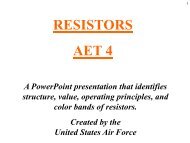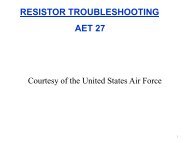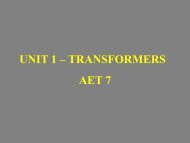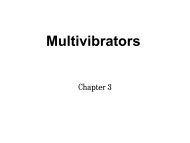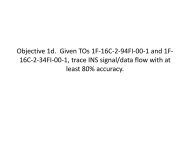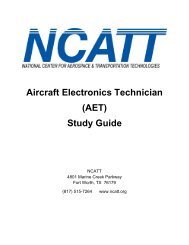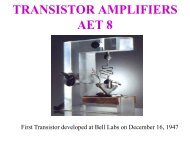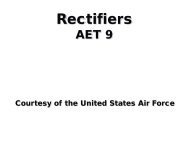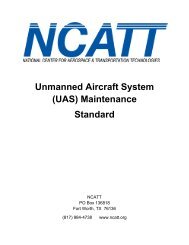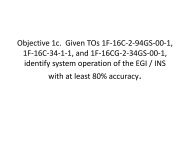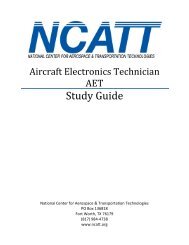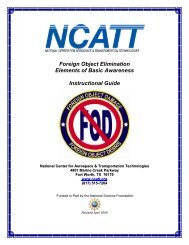NCATT FOE Standard
NCATT FOE Standard
NCATT FOE Standard
- No tags were found...
Create successful ePaper yourself
Turn your PDF publications into a flip-book with our unique Google optimized e-Paper software.
Foreign Object Elimination (<strong>FOE</strong>)Elements of Basic Awareness<strong>Standard</strong>National Center for Aerospace & Transportation Technologies4801 Marine Creek ParkwayFort Worth, TX 76179www.ncatt.orgU(817) 515-7264
<strong>NCATT</strong> <strong>FOE</strong> – Elements of Basic Awareness <strong>Standard</strong>Subject, Performance and Task Knowledge RequirementsREFERENCES / RESOURCES• FAA Advisory Circulars 150/5370-2E &150/5380-5B (www.faa.gov)• Guidelines for The Prevention and Elimination of Foreign Object Damage/Debris (FOD) inthe Aviation Maintenance Environment Through Improved Human Performance, by David C.Kraus, Galaxy Scientific Corporation and Jean Watson, FAA Flight <strong>Standard</strong>s Service,Aircraft Maintenance Division (www.hf.faa.gov)• NAS 412 – Foreign Object Damage / Foreign Object Debris (FOD) Prevention AerospaceIndustries Association (www.aia-aerospace.org)• National Aerospace FOD Prevention Inc. Guidelines (www.nafpi.com)• National Center for Aircraft Technician Training (www.ncatt.org) PowerPoint <strong>FOE</strong> Basicsand other reference materials on the website• The FOD Control Cooperation (www.fodcontrol.com), (www.fodnews.com),(www.makeitfodfree.com)• Wildlife and Bird Strike Organization (www.birdstrike.org)Copyright © 2009 by the National Center Aerospace & Transportation Technologies. All rights reserved.Individuals may download, print, and make copies of this documentfor their own personal use. Commercial use prohibitedMay 2009.Page 3 of 17
<strong>NCATT</strong> <strong>FOE</strong> – Elements of Basic Awareness <strong>Standard</strong>Subject, Performance and Task Knowledge Requirements<strong>NCATT</strong> Level DefinitionsScaleValueDefinition: The IndividualTaskPerformanceLevels1 IS EXTREMELY LIMITED. (Can do simple parts of the task. Needs tobe told or shown how to do most of the task)2 IS PARTIALLY PROFICIENT. (Can do most parts of the task. Needsonly help on hardest parts.)3 IS COMPETENT. (Can do all parts of the task. Needs only a spotcheck of completed work.)4 IS HIGHLY PROFICIENT. (Can do the complete task quickly andaccurately. Can tell or show others how to do the task.)TaskKnowledgeLevels*SubjectKnowledgeLevelsExplanationsabcdABCDKNOWS NOMENCLATURE. (Can name parts, tools, and simple factsabout the task.)KNOWS PROCEDURES. (Can determine step-by-step procedures fordoing the task.)KNOWS OPERATING PRINCIPLES. (Can identify why and when thetask must be done and why each step is needed.)KNOWS ADVANCED THEORY. (Can predict, isolate, and resolveproblems about the task.)KNOWS FACTS. (Can identify basic facts and terms about thesubject.)KNOWS PRINCIPLE. (Can identify relationship of basic facts andstate general principles about the subject.)KNOWS ANALYSIS. (Can analyze facts and principles and drawconclusions about the subject.)KNOWS EVALUATION. (Can evaluate conditions and make properdecisions about the subject.)A task knowledge scale value may be used alone or with a task performance scale value todefine a level of knowledge for a specific task. (Example: b and 1b)*A subject knowledge scale value is used alone to define a level of knowledge for a subject notdirectly related to any specific task, or for a subject common to several tasks.Copyright © 2009 by the National Center Aerospace & Transportation Technologies. All rights reserved.Individuals may download, print, and make copies of this documentfor their own personal use. Commercial use prohibitedMay 2009.Page 4 of 17
<strong>NCATT</strong> <strong>FOE</strong> – Elements of Basic Awareness <strong>Standard</strong>Subject, Performance and Task Knowledge RequirementsI. Basic Terms & DefinitionsLevel AIdentify, define and explain the following basic aviation and aerospace industry<strong>FOE</strong>/FOD terms and definitions.• FO (Foreign Object)—Sometimes referred to as Foreign Object Debris (FOD)– Any alien substance or article that invades any component of the aircraftand which causes or has potential to cause damage to aircraft, persons,equipment, or otherwise diminish safety.• FOD (Foreign Object Damage)—Any damage or incident attributed to aforeign object that can be expressed in physical or economic terms whichmay or may not degrade the product’s required safety and/or performancecharacteristics.• <strong>FOE</strong> (Foreign Object Elimination)—A program or process used to assure aFOD-free product/system.• Potential FOD – The condition where foreign object debris may causedamage, and/or failure should the product be put into use.• FOD Designated Area— (Also referred to as FOD Critical (NAS 412) or FODSensitive)—Any area where flight hardware is in place and exposure toforeign objects would potentially cause a system or product failure due todeterioration, malfunction or damage.• FOD Barriers—Devices such as edge protectors, caps, plugs, and protectivecovers used for hoses, cables, ducts, electronic components and otherhardware exposed to potential damage.• FOD Walk / Sweep—Physical inspection and removal of FO in an assignedarea or a zone.• Critical FO— Any material that is inadvertently left inside an assembly afterclose out or test and any foreign objects in areas from which migration ispossible, (e.g., through tooling holes, bend relief cutouts, drain holes, intakes,etc.) which are probable to cause system or component malfunction ordeterioration should the product be put into use.• Clean As You Go—An ongoing process of removing work debris and keepingthe work area clean while performing a task on a product.Copyright © 2009 by the National Center Aerospace & Transportation Technologies. All rights reserved.Individuals may download, print, and make copies of this documentfor their own personal use. Commercial use prohibitedMay 2009.Page 5 of 17
<strong>NCATT</strong> <strong>FOE</strong> – Elements of Basic Awareness <strong>Standard</strong>Subject, Performance and Task Knowledge Requirements• Consumables / MSP (Miscellaneous Small Parts) and PLS (Production LineStock)—Supplies provided to workers that are expendable. Examples are:o Issued apparel (e.g. gloves, hair nets, snoods, booties etc.)o Safety glasses and shop coatso Glue, paint, sealanto Rags, gauze pads, swabso Sandpaper, brushes, applicators, paper, pens, plastic coverso Stock items (e.g. rivets, washers, fasteners and other hardware)o Perishable Tools (e.g. drills, reamers, apex tips)• Housekeeping—Is the responsibility of employees to maintain a clean andorderly work area with necessary tools, materials, and equipment in theirplaces of orderly arrangement.• Focal Point— A FOD Focal Point should develop and implement plans andprograms to prevent damage to aerospace products during associateddesign, manufacturing, assembly, test, acceptance, packaging, handling,storage, transporting, maintenance, flight line, and launch operations. TheFocal Point assures that FOD incidents are thoroughly investigated and thatincident reports are completed as applicable. The Focal Point(s) should beappointed by upper level management (e.g. the chief operating official) andhave sufficient authority and organizational freedom to identify and implementFOD preventive measures whenever and wherever required. The Focal Pointis described in detail in NAS 412.• FOD Point of Contact (FOD POC) / Local FOD Coordinator—The FOD Pointof Contact is in charge of and in direct control of FOD Designated Areas,including personnel entry, tool control logs, FOD audits, posting alerts andcompleting FOD Incident Reports. The Focal Point and the FOD Point ofContact work as a team. Students should understand that position titles andresponsibilities tend to change from organization to organization. FOD FocalPoint(s) and FOD POC tends to fall into organizational specific structure andtitling differences. Typically organizations that do not identify a Focal Pointand a FOD Point of Contact as separate and unique positions will blend theresponsibilities of the Focal Point and the FOD Point of Contact. In at leastone large aerospace manufacturing organization the FOD Point of Contactposition is known as the Local FOD Coordinator. Regardless of titles andlevels of responsibility the work of a FOD Focal Point / FOD Point of Contact /Local FOD Coordinator is significant. The FOD POC is not defined oraddressed (as a unique position) in NAS 412 but FOD POC does appear inother <strong>FOE</strong> / FOD materials including FAA advisory circulars and FAAguidelines.Copyright © 2009 by the National Center Aerospace & Transportation Technologies. All rights reserved.Individuals may download, print, and make copies of this documentfor their own personal use. Commercial use prohibitedMay 2009.Page 6 of 17
<strong>NCATT</strong> <strong>FOE</strong> – Elements of Basic Awareness <strong>Standard</strong>Subject, Performance and Task Knowledge RequirementsII.Housekeeping<strong>NCATT</strong> Level BIdentify the relationship of basic facts and state general principles relevant to theaviation and aerospace industry methodology (terms, tools and processes) onhousekeeping.• Clean As You Go Programs utilize practices to prevent FOD from migratinginto aviation products. Clean As You Go Programs provide an ongoingprocess of removing work debris as it accumulates and keeps the work areaclean while tasks are performed on products, vehicles, or assemblies in aFOD designated area.Paperwork is often a tool that technicians use to complete task or to trackand account for loose parts. The technician must remember that items(paper, pens, pencils, staples, paperclips, and other office supplies) usedwith paperwork can sometimes become Foreign Objects themselves.Controlling loose office supplies is an important component of Clean AsYou Go Programs. It is important to always be conscious of personalactions around a FOD sensitive product, vehicle or assembly.All employees should ensure the work area is clean:o prior to starting an operationo as an operation progresses and work debris accumulateso when an operation cannot continueo after an operation is completed and prior to inspectiono at the end of each shift• FOD Cans and Containers—Foreign Object Debris cans and containers arestrategically placed in FOD designated areas. FOD cans and containers arevery useful tools in preventing foreign objects from migrating into aerospaceproducts. It is everyone’s responsibility to utilize FOD cans and containers forany trash or foreign material in a FOD designated area.• FOD Bags (typically worn by individuals) —A method of placing and securingany personal belongings such as change, contents of one’s pockets, jewelry(chains, necklaces, earrings, rings, watches), sun glasses, badges or anyitem that has the potential to become a Foreign Object. These bags are wornwhile visiting or working in a FOD designated area. Some FOD programsrestrict the use of these bags to personal items only while other programsallow FOD bags to be used for collection of debris. FOD bags are not usedfor tool storage or transport (see “Tool Pouches / Tool Pockets / Tool Bags” inthe Tool Accountability <strong>Standard</strong> #3).Copyright © 2009 by the National Center Aerospace & Transportation Technologies. All rights reserved.Individuals may download, print, and make copies of this documentfor their own personal use. Commercial use prohibitedMay 2009.Page 7 of 17
<strong>NCATT</strong> <strong>FOE</strong> – Elements of Basic Awareness <strong>Standard</strong>Subject, Performance and Task Knowledge RequirementsNote: Typically work residue (e.g. scrap wire cuttings, string ties) generatedduring the shift may be temporarily stored in a FOD Bag or otherdesignated FOD Container until they can be discarded properly.• 5S—Sort, Straighten, Shine, <strong>Standard</strong>ize, and Sustain, is a method thatdescribes a Japanese concept for housekeeping and organization of theworkplace. The 5S philosophy is appropriate and is used in many FODprogram because good housekeeping processes and habits have asignificant positive impact on FOD prevention. Some companies use 6Swhich includes Safety. In order to launch a 5S or 6S event all employees inthe area participate to organize the area using the Sort, Straighten, Shine,<strong>Standard</strong>ize, and Sustain process. Organization methods that include tapingoff areas, color coding and organizing tool cabinets are utilized. A map of thearea is created displaying each assigned location.• Permanent Tooling—At completion of any major or minor permanent toolmaintenance or upgrade (may include facilities) FOD designated areas mustbe completely swept for all foreign objects, ensuring that all foreign objectsare removed prior to area activation.III.Tool Accountability<strong>NCATT</strong> Level BIdentify the relationship of basic facts and state general principles about the followingterms, definitions, methods, devices and process used to provide Tool AccountabilityMethods.• Tool Control – Any formal system designed to assure that each tool that goesonboard an aircraft is removed and accounted for.• Shadow Box / Board— A toolbox or storage board with specifically, markedlocations (e.g. foam cutouts) for each tool in the tool box or storage board sothat a missing tool is readily noticeable. A tool box or storage board can beinventoried in 60 seconds or less. Shadow boxing with foam cutouts is verypopular and is often used in conjunction with other methods.• Tether—A lanyard of sufficient length and strength (wire, rope, cable, etc.)that is secured to the technician (user), structural workstand or other suitablelocation at one end (as appropriate) and the tool or equipment at the otherend. The tether should be minimum length to preclude damage from tetheredtool “free swing.” Tethering prevents dropping tools or equipment into or ontoaircraft or other aerospace products. The tether itself can become FOD if it(including tether related hardware) is not regularly examined for damage andwear.Copyright © 2009 by the National Center Aerospace & Transportation Technologies. All rights reserved.Individuals may download, print, and make copies of this documentfor their own personal use. Commercial use prohibitedMay 2009.Page 8 of 17
<strong>NCATT</strong> <strong>FOE</strong> – Elements of Basic Awareness <strong>Standard</strong>Subject, Performance and Task Knowledge Requirements• Chit System— A chit is an assigned identification tag issued to a techniciandisplaying a control number. Technicians replace any tool that they removefrom a tool box with their assigned tag (chit). If another technician or areasupervisor inventories the tool box, the chit system accounts for the missingtool and identifies the technician that is in possession of the tool. For thismethod of tool accountability to be effective tool boxes must be shadowboxed with specifically marked locations for each tool and technician mustfollows the one-for-one policy of removing a tool and replacing the tool withtheir assigned tag. If not controlled chits can become FOD themselves. It isthe responsibility of every technician to control his or her chits, especially inthe FOD designated areas. Chits can also be used to designate that a toolhas been removed from the tool box for repair or calibration.• Tool Inventory Sheets / Logs—Written Tool Inventory Sheets / Logs are alisting of tools and materials that must be checked in and out when enteringor departing a FOD designated area. Completed Tool Inventory Sheets / Logsare required prior to the FOD designated area closeout.• Tool Pouches / Tool Pockets / Tool Bags — A tool control pouch that containsan identified (inventoried) set of tools. The tool pouch is subject to logging inand out, or chitting.• Tool Identification—Tools are marked for issue, return and accountability.Every tool that is assigned to a specific area or tool box is marked with one ormore of the following methods:o Tagso Sensorso Bar Codeso Laser Etching/Engravingo Color Code• Consolidated Tool Kits—Also known as “CTK” are specific tool boxes with alltools inside assigned to the specific tool box. This tool box is inventoried bytool crib personnel or area supervision. The tool box has foam cutouts ormagnetic storage containers, and is shadow boxed for easy inventory.Consolidated Tool Kits have replaced technician’s “personally provided” toolsand tool boxes in most aerospace industry operations.Copyright © 2009 by the National Center Aerospace & Transportation Technologies. All rights reserved.Individuals may download, print, and make copies of this documentfor their own personal use. Commercial use prohibitedMay 2009.Page 9 of 17
<strong>NCATT</strong> <strong>FOE</strong> – Elements of Basic Awareness <strong>Standard</strong>Subject, Performance and Task Knowledge Requirements• Tool Condition—Assuring that a tool’s condition is clean, undamaged and freeof Foreign Objects prior to use is a professional FOD prevention method. It isvery important to visually inspect tools for all the conditions described herein.Tool condition inspections should be accomplished prior to and immediatelyafter job completion.o Broken or Worn Tools—Visually inspect tools for broken or worn areasthat can become FOD.o Damaged—Any damaged tools should be repaired or replaced to preventthe damaged tool from becoming FOD.o Dirty—Ensure the tools are clean and ready for use prior to each use.o Flaking— (Chrome flaking) Flaking is a hidden foreign object and canbecome a serious problem if undetected.• Sponge Count—A formal procedure utilizing a written record of all itemsentering and leaving a work area. The medical industry uses this procedure toensure that all surgical materials that are taken into a surgical operation areaare properly accounted for at the end of the surgical procedure. Therebypreventing FOD (a sponge, surgical tool, etc.) from accidentally beingintroduced or left inside a patient. Applying the “sponge count” methodologyin aerospace industry settings ensures that foreign objects (Critical FO) arenot left inside aerospace products, assemblies or vehicles.• Electronic Tool Accountability System—Tools can be tracked to a user by aunique identifier such as a badge. The electronic tool accountability systemutilizes electronic sensors and/or bar codes that identify each individual tool(see “Tool Identification” in this section).IV.Hardware Accountability<strong>NCATT</strong> Level BIdentify the relationship of basic facts and state general principles about HardwareAccountability and describe the methods for controlling hardware.• Hardware – A general term for all of the small components, such as nuts,bolts, screws, and washers used to assemble aerospace components,products and vehicles.Copyright © 2009 by the National Center Aerospace & Transportation Technologies. All rights reserved.Individuals may download, print, and make copies of this documentfor their own personal use. Commercial use prohibitedMay 2009.Page 10 of 17
<strong>NCATT</strong> <strong>FOE</strong> – Elements of Basic Awareness <strong>Standard</strong>Subject, Performance and Task Knowledge Requirements• Kitted Hardware—A kit that contains the exact amount of hardware assignedto perform a specific task. For example, to build a harness the exact amountof hardware, wire, plastic ties, and wrapping to complete the task is suppliedto the technician. Use of kitted hardware ensures the technician has no sparehardware, and must use all of the hardware that is provided in the kit tosuccessfully complete the task. If hardware becomes lost it is readilynoticeable because the task will be incomplete by the amount of losthardware. Early recognition that the hardware has been lost brings aboutearly reporting of the lost hardware and immediate follow-up.• Hardware Removal, Control and Replacement—If hardware is removedduring maintenance, alteration or other task the removed hardware must becontrolled and accounted for. Procedures used to control and account forremoved hardware may differ from one organization to another, butestablished procedures must be followed. Failure to follow establishedprocedures is often a major contributor in the creation of foreign objects.• Hardware Storage— During the manufacturer, maintenance, repair oralteration of an aerospace product, assembly or vehicle it is critical to havehardware contained in a manner that does not promote migration to theproduct as FOD. As hardware storage moves closer to FOD designatedareas, greater preventive and control features should be implemented.• Tote Trays and Containers—A Tote Tray is a covered device for storing,carrying, or transporting hardware in a secure manner to prevent inadvertentdroppings. Tote Trays and Containers are closed devices utilizing springloaded lids (compared to open containers or loosely held hardware). ToteTrays and Containers are effective hardware control devices that help controland prevent accidental spillage of hardware. Hardware spillage prevention isan important element in FOD control and is extremely important whenworking over (above) an aerospace product, vehicle, or assembly. Droppedhardware from above tends to find its way into the most inaccessible andcritical location.Copyright © 2009 by the National Center Aerospace & Transportation Technologies. All rights reserved.Individuals may download, print, and make copies of this documentfor their own personal use. Commercial use prohibitedMay 2009.Page 11 of 17
<strong>NCATT</strong> <strong>FOE</strong> – Elements of Basic Awareness <strong>Standard</strong>Subject, Performance and Task Knowledge RequirementsV. Lost Items<strong>NCATT</strong> Level BIdentify the relationship of basic facts and state general principles of reporting lost orfound items.• Report Missing, Lost and Found Items—This is an integral part of having asuccessful FOD Program and all technicians are encouraged and responsibleto report missing, lost or found items. Typically there is a documentedprocess of steps that are to be followed, and is designed to ensureemployees will report lost items before they cause damage. At most facilitiesthere are NO repercussions for reporting a lost or missing tool or item even ifthe technician is at fault. Although established as a positive self reportingmethod, repeat offenders may face disciplinary action.• If an item is lost during an assembly, manufacturing, or maintenance task,cease activity in the affected area and initiate a search for the item. Continuethis search until the item is found or adequate assurances are made that theitem is not contained in the aircraft, aerospace vehicle or assembly.Searching for such items may require de-paneling or nondestructiveinspections, including flashlight and mirror, borescope and x-ray. If an itemcannot be located after a search has been completed, annotate the applicableforms with a description of the item and the search procedure that wasfollowed.VI.Physical Entry & Personnel Control<strong>NCATT</strong> Level BIdentify the relationship of basic facts and state general principles about physical entryinto both flight hardware and FOD designated areas.• General Entry—When physical entry is required into flight hardware (e.g.,crew compartment, engine intake, exhaust, fuel tank areas, etc.) personnelshould remove all loose objects, badges, jewelry, etc., from clothing.Pocketless or closed zippered pocket coveralls should be worn to precludeforeign objects dropping from pockets.• Designated Areas—A FOD designated area is any area where flight hardwareis in place and exposure to foreign objects would potentially cause a systemor product failure due to deterioration, malfunction or damage.o Most manufacturing companies identify FOD designated areas based on arisk assessment of the potential for FO to migrate into the final product.Requirements for entry into and working within these areas increase asthe final product progresses through the factory to customer delivery.Copyright © 2009 by the National Center Aerospace & Transportation Technologies. All rights reserved.Individuals may download, print, and make copies of this documentfor their own personal use. Commercial use prohibitedMay 2009.Page 12 of 17
<strong>NCATT</strong> <strong>FOE</strong> – Elements of Basic Awareness <strong>Standard</strong>Subject, Performance and Task Knowledge Requirementso FOD designated areas whether found in manufacturing operations, repairstation or general repair facilities, are selected and defined by theindividual aerospace operator in accordance with their particularoperational requirements. FOD designated areas are typically identifiedas: FOD Awareness, FOD Sensitive, FOD Critical, FOD Restricted andFOD Controlled. Entry into these areas is limited in accordance with theorganization’s established FOD/<strong>FOE</strong> Program Procedures. Theprocedures may include training and/or certification(s) coupled toappropriate authorization.VII.Reporting & Investigating<strong>NCATT</strong> Level AIdentify basic facts and terms about reporting Foreign Object Damage incidents andinvestigation requirements.• All Foreign Object Damage should be reported immediately and investigatedas soon as possible. When a FOD incident occurs, operations shouldimmediately cease and an investigation should be initiated to determine thecause. Cause and corrective action should be attained in a timely manner topreclude similar occurrences in the future - “lessons learned.” Cause may bedetermined by visual observation, forensic analysis or by location of theobject.• Follow established procedures for formally reporting FOD incidents as theymay vary from company to company.• All FOD incidents reports should be forward to the FOD Focal Point (seedefinitions) for investigation, cause and corrective action.Copyright © 2009 by the National Center Aerospace & Transportation Technologies. All rights reserved.Individuals may download, print, and make copies of this documentfor their own personal use. Commercial use prohibitedMay 2009.Page 13 of 17
<strong>NCATT</strong> <strong>FOE</strong> – Elements of Basic Awareness <strong>Standard</strong>Subject, Performance and Task Knowledge RequirementsVIII.Material Handling<strong>NCATT</strong> Level BIdentify the relationship of basic facts and state general principles related to materialhandling.• A well-established plan for material handling and parts protection caneliminate many potential FOD hazards• Control Techniqueso Materials and accessories used in the packaging, handling, shipping andstorage that have intimate contact with the part or assembly should beclean and free of contamination.o Parts and assemblies should be packaged in a manner that will precludeany chance of one item making contact with another during normalhandling operations.o Protective and packaging materials should be chosen based on theirability to adequately resist penetration by tearing, parting or piercing fromforces either external or internal during normal handling operations.o Specific instructions for packaging, unpackaging, handling should befollowed when provided.o Protective devices/FOD Barriers (edge protectors, caps, plugs, covers,filters, rub strips) should be cleaned and secured to prevent accidentaldamage.*Refer to <strong>NCATT</strong> <strong>Standard</strong> #9 for additional information.o Once installed, unauthorized removal of the protective devices isprohibited and should be controlled through assembly or maintenancepaperwork.• Consideration should be given to the visibility / detection of material used forprotection so that the material itself doesn’t become FOD.• Material Characteristicso Materials should be compatible with the environmental and physicalstresses expected to be encountered during product service.o Electro-Static sensitive devices should be properly protected to avoiddamage. Materials that are used to protect electro-explosive devices andsensitive electronic components should be kept clean, covered, andstored away from ordinary non-static safe materials.Copyright © 2009 by the National Center Aerospace & Transportation Technologies. All rights reserved.Individuals may download, print, and make copies of this documentfor their own personal use. Commercial use prohibitedMay 2009.Page 14 of 17
<strong>NCATT</strong> <strong>FOE</strong> – Elements of Basic Awareness <strong>Standard</strong>Subject, Performance and Task Knowledge Requirements• Condition—Visually inspect all packaging, handling, shipping and storagecontainers for the following:o Nicks, dents, holes, abrasions, scratches, bums, etc., which may bedetrimental to the function and integrity of the part or assembly.o Grease, preservatives, corrosion products, weld slag, shop dirt, and othermaterials foreign to the item.• Packaging / Containers—Packaging methods, materials and processes,including storage and shipping containers can be a source of FOD and couldresult in damage. In some cases there may be design considerations for FODsensitive products, vehicles or assemblies that require the use of specificpackaging and / or containers. In other applications the designconsiderations may forbid the use of a specific packaging or container. In allcases the proper packaging and/or containers must be used.• Opening and Closing Containers—Caution must be taken when opening andclosing containers. Nailing, strapping or installing screws can cause damageto hardware or provide additional internal FOD in the container.• Storage—Follow the established storage procedures to prevent damage.Improper storage procedures can be a cause of Foreign Object Damage.• Transportation—Follow transportation procedures to prevent damage.Transporting FOD sensitive products can be a cause of Foreign ObjectDamage. This consideration includes the responsibility of transportationvehicles to be free of loose debris while transporting FOD sensitive products.IX.Parts Protections<strong>NCATT</strong> Level BIdentify the relationship of basic facts and state general principles related to partsprotection.• FOD Barrier—A device used to protect electronic components and otherhardware that are exposed to potential damage. It is a measure that preventsmigration and entrapment of Foreign Object Debris in a FOD sensitiveproduct. Devices such as edge protectors, caps, plugs, and protective coversthat are used to seal-off and provide protection for hoses, cables and ductsare FOD Barriers. FOD Barriers can be a cause of Foreign Object Damage ifnot controlled or accounted for properly.• FOD Barrier (Interior) Removal—Barriers placed inside lines to prevent FODmust be removed prior to closeout. Flags should be placed outside the line toremind personnel to remove interior barriers. Failure to remove FOD BarriersCopyright © 2009 by the National Center Aerospace & Transportation Technologies. All rights reserved.Individuals may download, print, and make copies of this documentfor their own personal use. Commercial use prohibitedMay 2009.Page 15 of 17
<strong>NCATT</strong> <strong>FOE</strong> – Elements of Basic Awareness <strong>Standard</strong>Subject, Performance and Task Knowledge Requirementsfrom fuel, hydraulic and vent lines has been, and continues to be, the causeof serious aviation incidents and accidents.• Electrostatic Discharge (ESD)—ESD can be considered a source of ForeignObject Damage. Electrostatic discharge is the instantaneous discharge ofstatic electricity that has built up on one surface or point and is discharged toanother surface or point. It is commonly seen and felt when a person walksacross a carpet or slides across a car seat and then reaches for the doorhandle. The zap that occurs is electrostatic discharge. Prior to coming intocontact with an ESD sensitive product technicians must ensure that allpotential static charge has been dissipated from their person through agrounding procedure. A recent example of ESD FOD occurred when anungrounded maintenance technician came into contact with the openelectrical terminal connection to a Full Authority Digital Engine Control(FADEC). The FADEC was destroyed. Replacement cost of the FADECexceeded $300,000 dollars. ESD is a complex subject with the potential forvery expensive and dangerous consequences. Technician should seekadditional and updated ESD training prior to handling ESD sensitive products.X. Hazardous Materials<strong>NCATT</strong> Level AIdentify the basic facts and terms related to the handling, control and disposal ofhazardous material.• Management of hazardous materials is important in the prevention of minorand major injuries to personnel and aerospace products. Mismanagement ofhazardous materials can lead to the inadvertent introduction of the materialinto or onto aerospace assemblies, components and vehicles resulting inForeign Object Damage.• Use and handling of hazardous materials must be performed in accordancewith the specific materials Material Safety Data Sheet (MSDS).• Disposition of hazardous materials is dependent upon the commodity that isbeing discarded. Disposal must be in accordance with federal, state and localhazardous material disposal procedures.Copyright © 2009 by the National Center Aerospace & Transportation Technologies. All rights reserved.Individuals may download, print, and make copies of this documentfor their own personal use. Commercial use prohibitedMay 2009.Page 16 of 17
<strong>NCATT</strong> <strong>FOE</strong> – Elements of Basic Awareness <strong>Standard</strong>Subject, Performance and Task Knowledge RequirementsXI.Wildlife/Environment<strong>NCATT</strong> Level AIdentify the basic facts and terms related to wildlife and environment issues that aremajor causes of Foreign Object Damage.• Wildlife—Can be a very dangerous source of Foreign Object Damage. Forexample a small animal can get into an aircraft and chew through wirescausing unknown damage. Unpredictable bird strikes continue to be a majorpart of Foreign Object Damage to aircraft and are very difficult to manage.Another wildlife factor to consider is the potential for Foreign Object Damagefrom rodent droppings that introduce foreign objects into aviation andaerospace products that may or may not cause damage, but will result in aninvestigation that can waste time and money.• Environment—Elements of weather are considered foreign objects. Snow,rain, hail, wind, and ice are foreign to the aircraft, product, or assembly andcan cause damage.XII.FOD Effects<strong>NCATT</strong> Level BIdentify the relationship of basic facts and state general principles related to FODeffects.• Costs—The aviation and aerospace industry is losing approximately 4 billiondollars annually to FOD. Insurance expenses (cost) to companies that haveincidents are increasing. In the manufacturing sector manufacturers mayincrease contract cost, which may lead to the loss of current or futurecontracts. In other aerospace operations (air carrier, repair organization orgeneral aviation) the cost can easily cause the failure of the business.• Life—Foreign Object Damage can have a direct impact on human lives. Thefamous Concord Crash in Paris, France had a devastating impact that killed113 people due to a foreign object. It is very important that the technicianunderstands the effects of Foreign Object Damage.Copyright © 2009 by the National Center Aerospace & Transportation Technologies. All rights reserved.Individuals may download, print, and make copies of this documentfor their own personal use. Commercial use prohibitedMay 2009.Page 17 of 17



